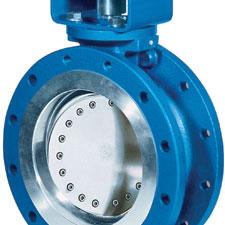- Contact Us
- Call Us
- Menu

Industrial process control often involves the control of fluid flow, ranging from slurries or petroleum to highly refined liquids and gases. The enormous variety of application specifics has given rise to a wide range of valves with performance characteristics to match those requirements. One common valve type is the butterfly valve. In it’s simplest form, it is a disc located in the path of fluid flow that is connected to a shaft. The disc rotates through a 90 degree arc to present either its face (valve closed) or its edge (valve open) to the fluid flow path. I wrote about some advantages and disadvantages of butterfly valves a couple months ago under the title “Is a Butterfly Valve Right for Your Application?“.
There is a variant of the simple version of the butterfly valve that provides distinct advantages for many applications. Referred to somewhat officially as a triple offset butterfly valve, it can also be more commonly called simply a triple offset valve.
The triple offset valve does away with the centric alignment of the shaft and disc, using instead a shaft mounting arrangement that relocates the shaft axis off both the center of the disc and the center of the bore. This shaft positioning, while creating a larger flow obstruction in the fully open position, sets the disc movement path in the proper alignment to take advantage of the third offset, which is the sealing surface. Triple offset valves have a different seals than other butterfly valve variants. There is an angular sealing surface, the angle of which is determined by sectioning an imaginary right angle cone shape that extends along the bore. However, the apex of the cone does not lie on the center of the bore. This inclination of the seal cone constitutes the third offset. You can see an illustration of this description in the document included below.
Different manufacturers may have slightly different feature sets, but this should help you consider the benefits of this butterfly valve variant. Though its initial cost may be higher, the expected lower maintenance requirement, longer service life, and better performance may be well worth it. Talk to a valve product specialist about your application. I’ve written many times that combining your process expertise with the up to date product knowledge of a professional sales engineer will produce a positive outcome.